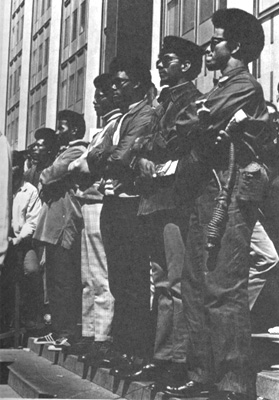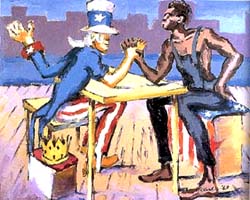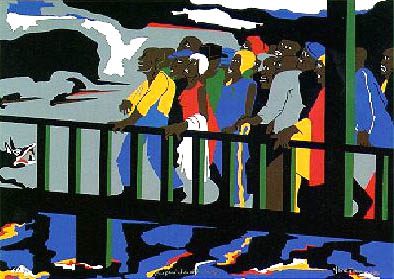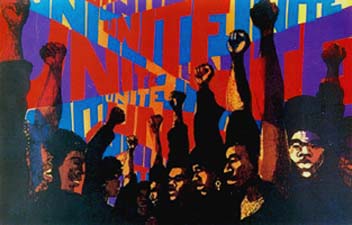|
|
|
Black
Arts Movement
|
|
General
History of BAM.
|
|
|
Since
the Post Bellum period of the Civil War, blacks have tried to attain the
status of mainstream America. This mainstream consisted of being
equivalent to whites socially, politically, educationally, and economically.
Despite Civil Rights legislation, blacks were still politically disenfranchised
and deprived economically. Revolution and forms of rebellion,
led by many mainstream activist, birthed a....... known as The Black
Arts Movement.
One major contributor to The Black Arts Movement, Stockley
Carmichael, stated that the emergence of this movement was
an outcry to the injustice done to black people and the death of
Malcolm X........... (link) Other means for rebellion were aimed
at social reform. In Black Awakening
in Capitalist America, author Robert Allen (link) states
social programs such as retraining programs were frequently unrealistic
in terms of the number of jobs that were actually available.
The programs that were instituted did not accommodate those at the bottom
of the economic ladder. Many women who were in these social programs
felt that they were being trained for unemployment. Such conditions
as these of oppression led to the formation or the beginning of Black
America as a separate entity of the American society.
The founding principles of this new Black America created
by the Black Arts Movement focused on black power, black economics, political
success, and a restructuring of the community that had been destroyed by
riots and police brutality. Instituting these principles was done
by using literature,
art, social institutions, and black activist groups as a channel.
The major players were writers such as Leroi
Jones, Larry
Neal, Maulana Karenga, and Dudley Randal. Most of their
work centered on literary works describing social conditions, commenting
political activity, and creating community establishments for the fine
arts. There were also some prominent women during this time, although
they may be marginalized at times. Women such as Sonia
Sanchez, Gwendolyn Brooks, Lorraine Hansberry, and Nikki Giovanni
can be recognized for their contributions in the literary aspects as well.
Just like any war and revolution, the Black Arts Movement
came to an end. However the social relevance, originality, dedication
to produce literary work that challenged mainstream America and define
black America did not go unnoticed. Black independent institutions,
publishing, and business outlets evolved from The Black Arts Movement.
One might can argue that the capitalist attitude of BAM is present in today's
black musical entrepreneurs. The success of many record labels and clothing
lines by artists Sean Puffy Combs, Master- P, and Jay-Z is a example of
BAM's Capitalist ideals. Also BET's success as the first network
for African American and their motto "Black Star Power" contains remnants
of The Blacks Arts Movement.
The Links on the left will take you to more information on
the Black Arts Movement, hope you enjoy! Please
e-mail with any questions or suggestions: e-mail

The style and beauty of the black woman during the
Black Arts Movement era

If I Were Jehovah, 1970
This painting is a an assertive revision of African American
poet Paul Laurence Dunbar's most noted poem "We
Wear the Mask." (link)As depicted in the work, the "mask"
African Americans historically used to shield the depth of their emotions
in a racist society is being ripped away in a full expression of outrage
and determination.
This image appears in the International Review of African American Art
vol.15, 1998.
|
|
 Black Panther
Black Panther .

Black Panthers
The Black Panthers political philosophy was to articulate
the basic desires and needs of the people and organize black people into
having some kind of power position. They believed that politics was
war without bloodshed. They advocated for an end to police brutality,
decent housing, better employment and educational opportunities, and the
freedom to determine the destiny of black people.
Re-Presenting the Struggle

Polarization
This image appears in The
International Review of African American Art vol.15, 1998.
In a 1972 letter to fellow African American artist
and art historian,
David C. Driskell, Claude Clark, Sr wrote: "Today,
[the black artist]
has reached the phase of Political Realism where his
art becomes even
more functional. He not only presents the condition
but names the
enemy and directs us towards a plan of action in search
of our own
roots and eventual liberation."

Confrontation at the Bridge, 1974
Jacob Lawrence
This image appears in the Frederick Weisman Art Museum.

Unite, 1971
Barbara Jones-Hogu
This image appears in The International Review of Africa American Art,
v.15, 1998.
|
|
Politics |
| Literature. |
|
|
Bibliography |
| . |
|
|
. |
|
|
|
|
|
|
|
|
|
|
|
|
|
|
|
|
|
|
|
|
|
|
Cultural Revolution and
the Black Arts Movement
of the 1960's
We would now like to take you on a journey
through some of works and pioneers of other
African Americans.
Theater
SHUFFLE ALONG
Not only was Harlem a mecca for black artists, but for many white
New Yorkers who took regular trips to see its exotic night life. They attended
black vaudeville shows, dramas, and Broadway plays. In the 1920s Harlem
and blacks in general would become the latest fad for middle class America.
The Harlem Renaissance reflected a desire to display African-American
cultural distinctiveness to the public. Some credit the black musical-comedy
Shuffle Along, which became a major Broadway hit, as the beginning of
the Harlem Renaissance. It included an all black cast and was written and
produced by blacks as well. Four men, Eubie Blake, Noble Sissle,
Flournoy Miller, and Aubrey Lyles, collaborated together to write it. Shuffle
Along was also the first musical-comedy to use a dramatic storyline, and
it would later revolutionize musicals on Broadway. But more important is
the success and popularity that it gained in order to launch the Harlem
Renaissance. When people flocked to the sold-out theaters to see the exciting
singing and dancing, it soon became a major Broadway hit, playing in New
York for a year and then going on tour for two years. The show also introduced
to Harlem Florence Mills who became one of the greatest black actresses
of the time.
BLACK THEATRICAL GROUPS
In 1914 blacks could only attend black theaters, and there were
only two- the Lincoln and Crescent theaters located on 135th Street between
Lenox and Fifth Avenue. These theaters were known as Harlem1s 3Off Broadway.2
The white theaters, or Harlem's "Broadway", were along Seventh Avenue &
125th Street. However, as more and more blacks moved closer to Seventh
Avenue these theaters removed their all-white policy and replaced it with
segregation. In most theaters blacks were forced to sit on the balcony
while the white patrons were allowed to sit in the better seats in the
orchestra. Only those "highly respectable" blacks were allowed to sit in
the orchestra among whites. Yet when segregation was abolished many of
these theaters, which were previously lagging behind financially, flourished.
Such was the case for the Lafayette theater which soon became the "most
stylish black showplace in Harlem". The black musical-comedy productions
they showed became quickly popular. Harlem1s first theater group was also
founded at the Lafayette in 1916. Charles Gilpin, who was considered one
of the most prominent black actors of the time, founded the Lafayette Players.
Although it was a black company, it did not perform black plays because
none had yet to exist. Even though the subject matter of these earlier
plays had little connection to the black American experience, they were
unique in that permitted black audiences to see black actors and actresses
in more serious roles rather than the same old, "usual song-and-dance routines".
Like the Lafayette Players there were a large amount of black
theater groups during the Harlem Renaissance. Others included the Harlem
Experimental Theater, the Krigwa Players, the Negro Art Theater, the Utopia Players,
and the Harlem Community Players. The large majority of these groups were
small, amateur groups that produced classics or melodramas on middle class life. Although
some of their plays did deal with black life and culture, few that were
produced were written by blacks.
Two highly successful plays written by white playwright Eugene
O1Neill were The Emperor Jones (1920) and All God1s Chillun Got Wings (1924).
Although The Emperor Jones brought to fame two black actors- Charles Gilpin
and Paul Robeson, and allowed them to play more serious roles, it was proof
that the greater number of successful plays at this time were written by
whites. The most remarkable thing about white plays was that black performers
were getting an unprecedented chance to do respectable and serious drama.
Although the majority of the black public was entertained by the
black dramas and vaudeville shows at this time, a group of black intellectuals
insisted that the commercial exploitation of Harlem by whites to at least result
in a black cultural development. Some felt the need for an authentic Negro
theater and for awhile the Krigwa Players produced works reflecting this idea. In the
latter part of the 1920s their plays included such topics as lynching and
the Underground Railroad. W.E.B. DuBois was one of their strongest promoters. He believed
that Negro drama could only be "evoked by a Negro audience desiring to
see its own life depicted by its own writers and actors". DuBois wrote
that the Negro theater "must be: I. About us. That is, they must have plots
which reveal Negro life as it is. II. By us. That is, they must be written
by Negro authors who understand from birth and continual association just
what it means to be a Negro today. III. For us. That is , the theater must
cater primarily to Negro audiences and be supported and sustained by their
entertainment and approval. IV. Near us. The theater must be in a Negro
neighborhood near the mass of ordinary Negro people". Although there was
some exceptions, DuBois goals would not be achieved in the Harlem Renaissance
because more of the black actors at the time were concerned with being
successful, and very few plays that dealt entirely with black history were
major hits. Also the scarcity of plays written by blacks was another factor.
ACTORS OF THE HARLEM RENAISSANCE
Charles Gilpin:
He first performed his singing, dancing, and comedy routines
in vaudeville and minstrel companies in Philadelphia. Later he moved to
New York where he became a founding member of the Lafayette Players. His first
big break was in 1919, when he played a slave in the historical drama,
Abraham Lincoln, on Broadway. This role led him to play the major role
in Eugene O1Neill1s Emperor Jones. The play, which became a sensation,
established Gilpin as the first black actor to be regarded as a serious
actor in theater.
Florence Mills:
As a young girl Florence toured with various vaudeville shows,
and it was these shows that gave her the opportunity to perform and be
discovered for her part in Shuffle Along. After this she did Dixie to Broadway and The Chocolate
Dandies, but it was her performance in Blackbirds, that later went on to
play in Paris and London, which made her the first black female star to win international
acclaim.
Paul Robeson:
In addition to being one of the greatest black actors in Harlem,
Paul Robeson was also a popular singer. Like Charles Gilpin he won fame
through his serious roles. He took over Gilpin's role in the Emperor Jones when the
play toured in London, and received exceptional reviews. After this he
performed in William Shakespeare's Othello.
 Paul Robeson as a
youngman.
Paul Robeson as a
youngman.
Langston Hughes
LH had a turbulent childhood, being the victim of multiple separations
between his father, Nathaniel Hughes and his mother, Carrie. His father,
a prosperous lawyer in Mexico, despised African-Americans for their stereotypical
lack of affluence. Writing poetry even in elementary school, LH once said
that he wrote "mostly because, when I felt bad, writing kept me from feeling
worse". After abandoning his engineering pursuit at Colombia University,
funded by his father, he became a Harlem poet, mentored by DuBois and "adored"
by Jessi Fauset, who was the literary editor of The Crisis. His first volume
of collected works, The Weary Blues was conceived upon his trips to Africa
and Europe on the SS Malone. Pursued by Alain Locke in Paris, Locke offered
LH a scholarship to Harvard and other opportunities. Returning to Harlem
from his European sojourn, he arrived at the official beginning of the
Harlem Renaissance.
Esthete In Harlem
The Negro Problem
Being wined and dined,
Answering the usual questions
That come to white mind
Which seeks demurely
To probe in polite way
I know I am
The Negro Problem
Being wined and dined,
Answering the usual questions
That come to white mind
Which seeks demurely
To probe in polite way
The why and wherewithal
I know I am
The Negro Problem
Being wined and dined,
Answering the usual questions
That come to white mind
Which seeks demurely
To probe in polite way
The why and wherewithal
Strange,
That in this nigger place
I should meet life face to face;
When, for years, I had been seeking
Life in places gentler-speaking,
Until I came to this vile streeet
And found Life stepping on my feet!
Dinner Guest: Me
I know I am
The Negro Problem
Being wined and dined,
Answering the usual questions
That come to white mind
Which seeks demurely
To probe in polite way
The why and wherewithal
Of darkness U.S.A.-
Wondering how things got this way
in current democratic night,
Murmuring gently
Over fraises du bois,
"I'm so ashamed of being white."
The lobster is delicious,
The wine divine,
And center of attention
At the damask table, mine.
To be a Problem on
Park Avenue at eight
Is not so bad
Solutions to the Problem,
Of course, wait.
Ku Klux
They took me out
To some lonesome place.
They said, "Do you believe
In the great white race?"
I said, "Mister,
To tell you the truth,
I'd believe in anything
If you'd just turn me loose."
The white man said, "Boy,
Can it be
You're a-standin' there
A-sassin' me?"
They hit me in the head
And knocked me down.
And then they kicked me
On the ground.
A klansman said, "Nigger,
Look me in the face-
And tell me you believe in
The great white race."
Cultural Exchange
In the Quarter of the Negroes
Where the doors are doors of paper
Dust of dingy atoms
Blows a scratchy sound.
Amorphous jack-o'-lanterns caper
And the wind won't wait for midnight
For fun to blow doors down.
By the river and the railroad
With fluid far-off going
Boundaries bind unbinding
A whirl of whistles blowing.
No trains or steamboats going-
Yet Leontyne's unpacking.
In the Quarter of the Negroes
Where the doorknob lets in Lieder
More than German ever bore,
her yesterday past grandpa-
Not of her own doing-
In a pot of collard greens
Is gently stewing.
Pushcarts fold and unfold
In a supermarket sea.
And we better find out, mama,
Where is the colored laundromat
Since we moved up to Mount Vernon.
In the pot behind the paper doors
On the old iron stove what's cooking?
What's smelling, Leontyne?
Lieder, lovely lieder
And a leaf of collard green.
Lovely Lieder, Leontyne.
You know, right at Christmas
Thye asked me if my blackness,
Would it rub off?
I said, Ask your mama.
Dreams and nighmares!
Nightmares, dreams, oh!
Dreaming that the Negroes
Of the South have taken over-
Voted all the Dixiecrats
Right out of power-
Comes the COLORED HOUR:
Martin Luther King is Governor of Georgia,
Dr. Rufus Clement his Chief Advisor,
A. Philop Randolph the High Grand Worthy.
In white pillared mansions
Sitting on their wide verandas,
Wealthy Negroes have white servants,
White sharecroppers work teh black plantations,
And colored children have white mammies:
Mammy Faubus
Mammy Eastland
Mammy Wallace
Dear, dear darlingold white mammies-
Sometimes even buried with our family.
Dear old
Mammy Faubus!
Culture, they say, is a two-way street:
Hand me my min julep, mammy
Hurry up!
Make haste!
Justice
That Justice is a blind goddess
Is a thing to which we black are wise:
Her bandage hides two festering sores
That once perhaps were eyes.
American Heartbreak
I am the American heartbreak-
The rock on which Freedom
Stumped its toe-
The great mistake
That Jamestown made
Long ago.







 Paul Robeson as a
youngman.
Paul Robeson as a
youngman.